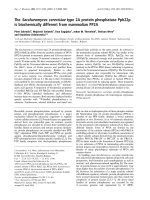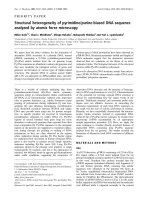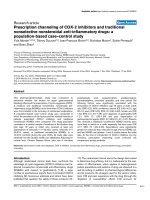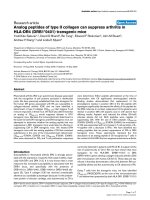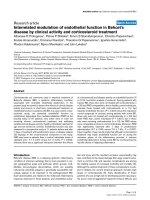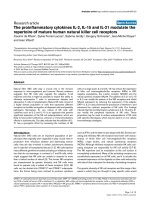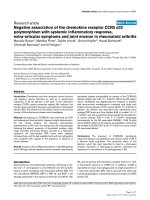Báo cáo y học: "The association of meat intake and the risk of type 2 diabetes may be modified by body weight"
Bạn đang xem bản rút gọn của tài liệu. Xem và tải ngay bản đầy đủ của tài liệu tại đây (161.37 KB, 8 trang )
Int. J. Med. Sci. 2006, 3
152
International Journal of Medical Sciences
ISSN 1449-1907 www.medsci.org 2006 3(4):152-159
©2006 Ivyspring International Publisher. All rights reserved
Research Paper
The association of meat intake and the risk of type 2 diabetes may be modified
by body weight
Raquel Villegas
1
, Xiao Ou Shu
1
, Yu-Tang Gao
2
, Gong Yang
1
, Hui Cai
1
, Honglan Li
2
, Wei Zheng
1
1. Vanderbilt Epidemiology Center, Vanderbilt University Medical Center and Vanderbilt-Ingram Cancer Center, 1215 21st
Avenue South, Nashville, TN 37232, U.S.A.
2. Department of Epidemiology, Shanghai Cancer Institute, 2200 Xie Tu Road, #25 Shanghai, 200032, People’s Republic of
China
Correspondence to: Xiao Ou Shu, M.D., Ph.D., Professor, Department of Medicine Vanderbilt University, Vanderbilt
Epidemiology Center, 1215 21st Avenue South, 6th fl. Med Ctr East, Rm 6009, Nashville, TN 37232-8300. Tel: 615-936-0713 Fax:
615-936-1269 E-mail:
Received: 2006.07.07; Accepted: 2006.10.25; Published: 2006.10.27
Aim: To investigate the association between meat intake and incidence of type 2 diabetes (type 2 DM) in a large
cohort of middle-aged women.
Design, subjects and methods: Incident cases of type 2 DM were identified during an average of 4.6 years of
follow-up in a prospective cohort study of 74,493 middle-aged, Chinese women (mean age ± SD =51.7± 8.97
years). Participants completed in-person interviews that collected information on type 2 DM risk factors such as
dietary factors and physical activity in adulthood. Anthropometric indices were measured. Dietary intake was
assessed using a validated food frequency questionnaire (FFQ). We included in the current analysis 70,609
women who had no prior history of type 2 DM at study recruitment and who had valid dietary data. The
association of type 2 DM with unprocessed meat intake (g/day) and the frequency of consumption of processed
meat was evaluated using the Cox model with adjustment for age, kcals/day, body mass index (BMI), waist to
hip ratio (WHR), vegetable intake, smoking, alcohol consumption, physical activity, income level, education level,
occupation status, and history of hypertension and chronic disease at baseline.
Principal results: We identified 1972 incident cases of type 2 DM during a total of 326,581 person-years of follow
up. Intake of unprocessed meat, particularly poultry, was associated with a decrease in the risk of type 2 DM in
this cohort. The fully adjusted relative risks (RRs) for quintiles of total unprocessed meat intake were 1.00, 0.78,
0.83, 0.74, and 0.83 (P for trend: <0.01). When the joint effect between meat intake and BMI categories was
evaluated, high intake of total unprocessed meat appeared to be associated with an increased risk of type 2 DM
among obese women but a reduced risk among lean women (P value for the interaction tests = 0.05). Processed
meat consumption was positively associated with the risk of type 2 DM. The adjusted RR was 1.15 (95% 1.01-1.32)
in women consuming processed meats compared to those who did not consume processed meats (P=0.04).
Conclusions: Processed meat intake was positively associated with the risk of type 2 DM. There was an
indication that the effect of unprocessed meat intake on type 2 DM may be modified by BMI.
Key words: type 2 diabetes, meat intake, middle-aged women
1. INTRODUCTION
A diet high in red meat has been suspected as an
independent contributor to the risk of type 2 diabetes
mellitus (type 2 DM) in ecological and migrant studies
[1;2]. However, data on associations between total
meat and type of meat intake and the risk of type 2 DM
are inconsistent and limited [3]. Total meat intake was
associated with a higher risk of diabetes in one
cross-sectional study, the Seventh Day Adventist
Study, a population with a large proportion of
vegetarians [4]. Red meat was associated with a higher
diabetes risk in prospective studies of female health
professionals, the Women’s Health Study (WHS) [3]
and in the Nurses’ Health Study (NHS) I and II [5;6],
but not in the Health Professionals Follow-up Study [7].
Poultry intake was related to a moderate decrease in
risk in one study [6]. Processed meat was associated
with a higher risk of type 2 DM in four prospective
studies [3;5-7]. The available data on the association
between meat intake and the risk of type 2 DM are
limited to four health professionals cohorts and the
Seventh Day Adventist cross-sectional study and thus,
may not be directly generalizable to the general
population.
To better understand the relationship between
the intake of meat and the risk of type 2 DM we
prospectively investigated the association between
meat consumption and the incidence of type 2 DM in a
population-based cohort of middle-aged women in
urban Shanghai.
2. METHODS
Study population
The Shanghai Women’s Health Study (SWHS) is a
population-based prospective cohort study conducted
Int. J. Med. Sci. 2006, 3
153
in seven urban communities in Shanghai, China.
Details of the SWHS survey have been reported
elsewhere [8]. Briefly, all eligible women (n=81,170)
who were aged 40-70 years and resided in these
communities were contacted. Participants were
identified using a roster obtained from the resident
registry offices in the study communities. A trained
interviewer visited potential study participants’ homes,
explained the study, obtained written consent and
administered an interview between March 1997 and
May 2000. A total of 75,221 women were enrolled,
yielding a participation rate of 92.7%. After exclusion
of 278 women who were later found to be younger
than 40 or older than 70 at the time of the interview,
74,942 women remained for the SWHS. The major
reasons for non-participation were refusal (3.0%),
absence during the enrolment period (2.6%), and other
miscellaneous reasons (i.e., health, hearing, or
speaking problems; 1.6%). All study participants
completed a detailed survey including an in-person
interview for assessment of dietary intake, physical
activity, and measurement of anthropometrics and
other lifestyle factors. Protocols for the SWHS were
approved by the Institutional Review Boards of all
institutes involved in the study.
Dietary intake and other exposure information
Dietary intake was assessed through an in-person
interview using a validated food frequency
questionnaire (FFQ) [9] at the baseline survey and at
the first follow-up survey, which took place
approximately two years after study recruitment. A
total of 77 items and food groups were included on the
questionnaire, which covered about 90% of the
commonly consumed foods in Shanghai in 1996. For
each food item or food group, subjects were asked how
frequently (daily, weekly, monthly, yearly or never)
they consumed the food or food groups, followed by a
question on the amount consumed in lians (50g/lian)
per unit of time. A lian is the unit of weight in China
equivalent to 50 g.
The reproducibility and validity of the FFQ was
assessed in a random sample of 200 participants who
completed 24-hour dietary recalls twice a month
during a 12-month period and 2 FFQs that were
administered two years apart. Correlation coefficients
between the 24-hour dietary recall and the second FFQ
ranged from 0.59 to 0.66 for macronutrients, 0.41 to
0.59 for micronutrients, and 0.41 to 0.66 for food
groups. The correlation coefficient for red meat was
0.52 and for poultry 0.48. The correlations between the
2 FFQs were 0.48 to 0.51 for macronutrients and 0.47
for red meat and 0.49 for poultry [9].
For women who developed type 2 DM, cancer, or
cardiovascular disease between the baseline and
follow-up FFQs, only dietary data from the baseline
FFQ were included in this analysis. For other
participants the average of the baseline and follow-up
FFQ data were used in the analyses. The average daily
intake of individual food items (g/day) was combined
to compute intake of red meat (pork, beef, lamb, organ
meat), poultry (chicken, duck, goose), and total
unprocessed meat (red meat and poultry combined).
We also obtained information on the frequency of
consumption of processed meat. Processed meats
included smoked meat/bacon, salted meat/preserved
meat and Chinese sausage.
A structured questionnaire was used to collect
information on participant characteristics such as age,
level of education, family income, occupation,
smoking, alcohol consumption and history of
hypertension, coronary heart disease (CHD), stroke,
and cancer. Anthropometric measurements, including
weight, height, and circumferences of the waist and
hips, were taken at baseline recruitment according to a
standard protocol by trained interviewers who were
retired medical professionals [10]. From these
measurements, the following variables were created:
BMI: weight in kg divided by the square of height in
meters, WHR: waist circumference divided by hip
circumference.
A detailed assessment of physical activity was
obtained using a validated questionnaire [11]. The
questionnaire evaluated regular exercise and sports
participation during the previous 5 years and
provided information on daily activity such as walking,
stair climbing, cycling, household activities and daily
commuting to and from work (walking and cycling).
We calculated the metabolic equivalents for each
activity, using a compendium of physical activity
values [12]. One MET-h/d is roughly equivalent to
1kcal/kg/d or about 15 minutes of participation in
moderate intensity (4 METS) activity for an average
adult [12]. We combined each of the exercise and
lifestyle activity indices to derive a quantitative
estimate of overall non-occupational activity
(MET-hr/day).
Cohort follow-up and endpoint ascertainment
In-person follow-up for all living cohort members
was first conducted from 2000 to 2002 by an in-home
visit. Follow-up of disease outcomes was completed
for 74,755 of cohort members, a response rate of 99.8%.
A second in-home follow-up survey was launched in
May 2002 and completed in December 2004 with a
response rate of 98.7%; only 934 participants were lost
to follow-up.
Incident type 2 DM was identified through the
follow-up surveys. A total of 1972 new cases of type 2
DM were reported. For the current study we
considered a case of type 2 DM to be confirmed if the
participants reported having been diagnosed with type
2 DM and met at least one of the following criteria:
fasting glucose level of at least 7 mmol/L on at least
two occasions or an oral glucose tolerance test (OGTT)
with a value of at least 11.1 mmol/L and/or use of
hypoglycaemic medication (i.e., insulin or oral
hypoglycaemic drugs). The study outcome criteria
were met by 1094 participants, which are referred to
herein as confirmed cases of type 2 DM. We performed
analyses with both confirmed and all type 2 DM cases
and found similar trends. Thus, in this paper we
present results that include all self-reported cases of
type 2 DM. We excluded women from the current
Int. J. Med. Sci. 2006, 3
154
analysis who had diabetes or had a positive urinary
glucose test at the baseline survey. The total follow-up
was 4.6 years.
Statistical analysis
The Chinese Food Composition Tables [13] were
used to estimate intake of nutrients and energy
(kcals/day). We excluded participants who had
extreme values for total energy intake (<500 or > 3500
kcals/day) [14], (n=37), leaving 70,609 participants for
the analysis, of whom 1969 developed type 2 diabetes.
Person-years for each participant were calculated
as the interval between baseline recruitment to
diagnosis of type 2 DM, censored at death or last date
of contact. Total unprocessed meat intake, red meat
and poultry (g/day) were categorized by quintile
distribution with the lowest quintile serving as the
reference. Consumption of processed meats was low in
this population, thus we compared women who
consumed processed meat less than once per month or
at least once per month with women who did not
consume processed meats.
The Cox proportional hazards model was used to
assess the effect of meat intake on the incidence of type
2 DM. Socio-demographic factors and other risk factors
for diabetes such as age, kcal/day, BMI, WHR,
vegetable intake (all entered as continuous variables),
level of education (none, elementary school,
middle/high school, college), family income in
yuan/year (<10000, 10000-19999, 20000-29999, >30000),
occupation (professional, clerical, farmer/others,
housewife/retired), smoking (smoked at least one
cigarette per day for more than 6 months
continuously), and alcohol consumption (ever drank
beer, wine, or spirits at least 3 times per week),
physical activity (quintiles of METs), and hypertension
were adjusted for in the analyses as potential
confounders. We also adjusted for the presence of the
following chronic diseases at baseline: coronary heart
disease (CHD), stroke, and cancer and repeated the
analyses after exclusion of subjects with these chronic
diseases. Tests for trend were performed by entering
the categorical variables as continuous parameters in
the models.
Finally, we investigated the joint effect of meat
intake categories and BMI categories on the risk of
type 2 DM. Total unprocessed meat, red meat and
poultry were categorized into 3 groups (lower quartile,
second and third quartiles combined, and upper
quartile) and frequency of processed meat
consumption was categorised (never, less than once
per month, and at least once per month). BMI was
categorised according to WHO obesity categories [15].
The likelihood ratio test was used to assess the
significance of the interaction terms.
All analyses were performed using SAS (version
9.1) and all tests of statistical significance were based
on two-side probability.
3. RESULTS
In this study population we found that higher
intake levels of total unprocessed meat, red meat,
poultry, and consumption of processed meat (yes/no)
were associated with higher energy intake, alcohol
consumption, higher education and income level, and
being employed and were inversely associated with
leisure-time physical activity (Table 1). Participants
with higher intake of meat were more likely to be
younger and less likely to have ever smoked, have a
history of CHD, stroke, hypertension, or cancer.
Overall 12.35% of study participants did not consume
any processed meat. Smoked meat was consumed by
37.51% of study participants, while 81.31% of cohort
members had consumed salted/preserved meat and
46.24% consumed Chinese sausage (data not shown in
Table).
During the 4.6 years of follow up (326,625
person-years) we documented 1972 new cases of type 2
DM. We found that consumption of total unprocessed
meat and poultry was, in general, inversely related to
the risk of type 2 DM (Table 2). As compared with the
lowest quintile of intake, the multivariate adjusted RRs
of type 2 DM across quintiles were 1.00, 0.78, 0.83, 0.74
and 0.83 (p for trend <0.01) for total unprocessed meat
intake and 1.00, 0.74, 0.80, 0.69, and 0.78 for poultry (p
for trend <0.001). No clear linear dose-response was
evident for red meat intake. We repeated the analysis
after exclusion of participants already diagnosed with
chronic diseases (CHD, stroke, and cancer) and found
similar results (Table 2).
The risk of type 2 DM for participants who
consumed processed meat compared to those who did
not consume processed meat was 1.15 (95%CI 1.01-1.32
(Table 3). The fully adjusted RRs associated with
frequency of consumption were 1.00 for never, 1.20 for
<1/month, and 1.10 for ≥1/month (p for trend=0.67).
We repeated the analysis stratified by categories of
BMI. The adjusted relative risks for never, <1/month,
≥1/month were 1.00, 1.08 and 0.97 (p=0.56) in
participants with a BMI<25 kg/m
2
, 1.00, 1.22 and 1. 09
(p=0.99), in participants with a BMI between 25 and 30
kg/m
2
and 1.00, 1.44 and 1.51 (P=0.06) in participants
with a BMI>
30 kg/m
2
(data not shown in Table 3).
When types of processed meat were considered, we
found that salted/preserved meat consumption
(yes/no) was associated with a higher risk of type 2
DM (RR 1.16; 95%CI: 1.04-1.31, P<0.01), while
consumption of bacon/smoked meat or Chinese
sausage was unrelated to the risk of type 2 DM (data
not shown in Table 3). Analyses excluding participants
with chronic diseases at baseline showed similar
results. We investigated the association between
salted/preserved meat and the risk of type 2 DM
stratified by BMI categories (data not shown in Table
3). Salted/preserved meat intake (yes/no) was
associated with a higher risk of type 2 DM in
participants with a BMI >
30 kg/m
2
(RR 1.50; 95%CI:
1.11-2.03, P<0.01) but was not associated with the risk
of diabetes in participants with BMI<25 kg/m
2
or BMI
between 25 and 30 kg/m
2
.
We conducted further analysis to evaluate joint
associations between meat intake and obesity
categories and the incidence of type 2 DM (Table 4).
Int. J. Med. Sci. 2006, 3
155
We found that total unprocessed meat consumption
was associated with a modest reduction in risk of type
2 DM for normal weight participants, but related to a
modest increase in risk of type 2 DM for obese
participants (P for interaction: 0.05). A similar trend
was observed for red meat but the factor for interaction
failed to reach significance (P=0.16). Poultry was
modestly related to a reduction in the risk of type 2
DM for normal weight and overweight participants,
but was unrelated to the risk of type 2 DM in obese
participants and the interaction factor was of marginal
significance (P=0.07). Processed meats were associated
with a higher risk of type 2 DM in overweight and
obese participants (interaction factor P value =0.08).
Participants who were obese (BMI>
30 kg/m
2
) and in
the highest intake category of processed meat had a
higher risk of type 2 DM (RR= 3.46; 95% CI 2.67-4.48)
compared to participants with normal weight (BMI<25
kg/m
2
) who did not consume processed meat.
Analyses excluding subjects with chronic diseases at
baseline showed the same pattern, although the RRs
associated with processed meat intake among
overweight and obese women were more pronounced
(data not shown in tables). We repeated all the
analyses after exclusion of participants whose type 2
DM diagnosis could not be confirmed and found
similar trends (data not shown in tables).
4. DISCUSSION
In this large prospective study of middle-aged
Chinese women living in Shanghai, we found
differences in the association of unprocessed total meat
intake and type 2 DM risk depending on the BMI of the
women. A higher consumption of total unprocessed
meat was related to a modest reduction in the risk of
type 2 DM among normal weight women, but was
associated with a modest increase in risk of type 2 DM
among obese women. However, poultry consumption
was not associated with a higher risk of type 2 DM
among obese participants. Processed meat
consumption was associated with an increased risk of
developing type 2 DM, particularly for obese
participants.
Some studies have examined the association
between meat consumption and the risk of type 2 DM.
Total meat was associated with a higher prevalence of
diabetes in the Seventh Day Adventist Study
conducted in California [4]. In that study there was no
information on associations of different types of meat
and the risk of diabetes. Poultry consumption was
associated with a moderate decrease in risk of type 2
DM in the NHS II [6]. No association between poultry
consumption and risk of type 2 DM was found in the
Health Professionals Follow-Up Study [7], the WHS [3],
or the NHS I [5]. Poultry consumption has been
indirectly linked to lower risk of type 2 DM as high
consumption of poultry was found to be part of a
‘prudent dietary pattern’ that has been associated with
a lower risk of type 2 DM [5;16]. However, in a recent
report from the German arm of the European
Prospective Investigation into Cancer (EPIC) Study,
poultry consumption was part of a dietary pattern
associated with a higher risk of type 2 DM [17]. To our
knowledge there are no other reports of a direct link
between poultry consumption and risk of diabetes or
of interactions between poultry consumption and BMI
and the risk of type 2 DM.
Red meat consumption was associated with a
modest increase in the risk of type 2 DM in the WHS
(RR =1.28; 95%CI: 1.07-1.53), P<0.001 for the upper vs
lower quintile) [3] and in the NHS I (RR=1.22; 95% CI:
1.05-1.41 , P=0.03 for the upper vs lower quintile) [5].
Frequency of total red meat consumption was also
associated with a higher risk of type 2 DM in the NHS
II [6]. In the NHS II, beef and hamburgers, but not pork,
as a main dish were associated with a higher risk of
diabetes. However, no association between red meat
intake and the risk of type 2 DM was observed in the
Health Professionals Follow-Up Study [7], in which
consumption of red meat was 1.05, 95%CI 0.85-1.30 for
highest vs lowest quintile. Data from studies of Japanese
subjects living in Hawaii, indigenous subjects living in
Quebec, Canada, and a population in the UK [1;18;19] all
showed a positive association of red meat with type 2
DM risk either directly or as part of an unfavourable
dietary pattern. High levels of saturated fat, cholesterol,
animal protein, and heme-iron in red meat have all
been suggested as reasons behind the higher risk for
diabetes associated with high red meat intake [7].
In our population there was an indication that
red meat consumption was associated with a modest
decrease in risk of type 2 DM among normal weight
women and a modest increase in risk among obese
women, although the coefficient of interaction was not
significant. None of the previous studies evaluated the
interaction between BMI and meat consumption. Our
findings of inverse associations between red meat and
type 2 DM in participants with normal weight will have
to be confirmed in other study populations.
An important point to be considered when
interpreting these results is that the absolute amount of
red meat intake in this population was 42.6 g/day
(median). The cut off points for quintiles of red meat
intake in this population are 24.5, 36.5, 49.2 and 67.6
g/day. Several European countries participating in the
EPIC study have reported a much higher median
intake of red meat: 70.1 g/day [20] which is 1.4-fold
greater than the red meat intake in our study
population. Thus, it is possible that what is considered
a high level of intake in our population may not be
high enough to put participants at risk for type 2 DM.
In addition, in our population pork was the major
component of red meat intake (90%). Only beef and
hamburgers but not pork was associated with the risk
of type 2 DM in the NHS II [6]. In our population the
cut off points of red meat (other than pork) were 0.52,
1.63, 3.48 and 6.99 g/day.
Our results suggest that processed meat
consumption may be associated with a higher risk of
type 2 DM. This is broadly in agreement with other
studies that have found processed meat consumption
to be associated with a higher risk of type 2 DM. In the
Health Professionals Follow-Up Study the RR for
Int. J. Med. Sci. 2006, 3
156
diabetes was 1.46 (95% CI 1.14-1.86) for consumption
of processed meat ≥5times/week vs <1/month [7]. In
the WHS [3] total processed meat consumption
≥5/week vs <1/month had a RR of 1.43 (95%CI
1.17-1.75). Processed meat consumption has also been
associated with higher type 2 DM risk in the NHS I
and II [5;6]. In the NHS I the RR of type 2 DM for
intake of total processed meat was 1.38 (95%CI
1.23-1.56), for hot dog intake was 1.49 (95% CI
1.04-2.11), and for bacon intake was 1.73 (95% CI
1.39-2.16) [5].
The joint effects between processed meat intake
and obesity on the risk of type 2 DM was investigated
in the NHS II and frequent intake of processed meat
appeared to be associated with a higher risk of type 2
DM in women with a BMI ≥30 compared to women
with BMI <30, although the test for interaction was not
significant (p=0.34) [6]. In our study, we found similar
results and the test for interaction between processed
meat intake and BMI categories was of marginal
significance (P=0.08).
Processed meats contain preservatives and
additives that may put participants at a higher risk of
type 2 DM. These may include nitrites, nitrates, and
heterocyclic amines formed during cooking.
Nitrosamines formed during cooking may be toxic to
pancreatic cells [21]. Consumption of foods with a high
content of nitrites and nitrosamines has been
associated with type 1 diabetes [22;23]. In addition,
advanced glycation and lipo-oxidation end products
formed in meat and high fat products through heating
and processing have been associated with insulin
resistance in mice [24] and with diabetes complications
in humans [25]. However, observed associations
between processed meat consumption and type 2 DM
may also reflect other unidentified factors.
It may be possible that consumption of red meat
and processed meat may not increase the risk of type 2
DM, per se, but be part of a dietary pattern that has
been associated with a higher risk of type 2 DM. Red
and processed meats are two of the main components of
the ‘Western diet’, while poultry has been reported as
part of the ‘prudent diet’ in most studies [5;16;26], but
not all [17]. It remains unclear whether the possible
adverse effects that red and processed meat
consumption have on type 2 DM risk are mediated
through fat content or protein or if consumption of these
foods is associated with food groups in the ‘Western
diet’ which have been associated with a higher risk of
type 2 DM and hyperglycaemia [5;16]. To date only two
studies have reported an increase in the risk of type 2
DM associated with processed meat consumption
independent of this Western dietary pattern [5;6]. Our
study offers a unique opportunity to investigate
associations between meat intake and the risk of type 2
DM with little confounding from a Western dietary
pattern.
It is possible that participants who have been
diagnosed with a chronic disease may have changed
their diet. To address this concern we adjusted for the
presence of chronic disease (CHD, cancer, and stroke)
and hypertension throughout the analyses. We also
repeated the analyses excluding participants with
chronic diseases and found similar results.
The prospective design and high follow-up rates
in our study minimized the possibility of selection or
recall bias. In addition, the extensive information on
potential confounders and the large study size allowed
us to examine the effect of BMI and meat intake in
detail. Misclassification of dietary assessment would
most likely be non-differential and would have
attenuated the true associations. The repeated dietary
measurements are advantageous in helping to dampen
measurement errors and take into account changes in
eating behaviour over time.
In conclusion, we found that processed meat
consumption was associated with a higher risk of type
2 DM, independent of other type 2 DM risk factors.
Higher consumption of total unprocessed meat was
associated with a higher risk of type 2 DM among
obese women, although this was not the case for
poultry. There was an indication that total
unprocessed meat intake may be inversely associated
with type 2 DM among normal weight women. The
biological mechanisms for this possible interaction
should be investigated.
Acknowledgements
This study was supported by grant RO1
CA070867 from the National Institutes of Health.
Conflicts of interest
The authors have declared that no conflict of
interest exists.
References
1. Kawate R, Yamakido M, Nishimoto Y, Bennett PH, Hamman RF,
Knowler WC. Diabetes mellitus and its vascular complications
in Japanese migrants on the Island of Hawaii. Diabetes Care
1979; 2(2):161-170.
2. Pratley RE. Gene-environment interactions in the pathogenesis
of type 2 diabetes mellitus: lessons learned from the Pima
Indians. Proc Nutr Soc 1998; 57(2):175-181.
3. Song Y, Manson JE, Buring JE, Liu S. A prospective study of red
meat consumption and type 2 diabetes in middle-aged and
elderly women: the women's health study. Diabetes Care 2004;
27(9):2108-2115.
4. Snowdon DA, Phillips RL. Does a vegetarian diet reduce the
occurrence of diabetes? Am J Public Health 1985; 75(5):507-12.
5. Fung TT, Schulze M, Manson JE, Willett WC, Hu FB. Dietary
patterns, meat intake, and the risk of type 2 diabetes in women.
Arch Intern Med 2004; 164(20):2235-2240.
6. Schulze MB, Manson JE, Willett WC, Hu FB. Processed meat
intake and incidence of Type 2 diabetes in younger and
middle-aged women. Diabetologia 2003; 46(11):1465-1473.
7. van Dam RM, Willett WC, Rimm EB, Stampfer MJ, Hu FB.
Dietary fat and meat intake in relation to risk of type 2 diabetes
in men. Diabetes Care 2002; 25(3):417-424.
8. Zheng W, Chow WH, Yang G, Jin F, Rothman N, Blair A et al.
The Shanghai Women's Health Study: rationale, study design,
and baseline characteristics. Am J Epidemiol 2005;
162(11):1123-1131.
9. Shu XO, Yang G, Jin F, Liu D, Kushi L, Wen W et al. Validity
and reproducibility of the food frequency questionnaire used in
the Shanghai Women's Health Study. Eur J Clin Nutr 2004;
58(1):17-23.


